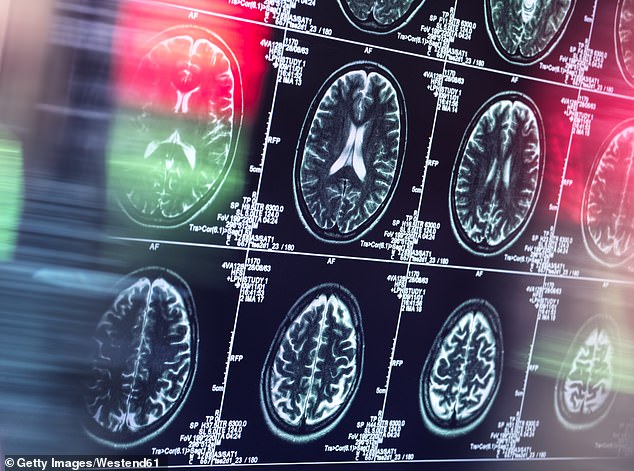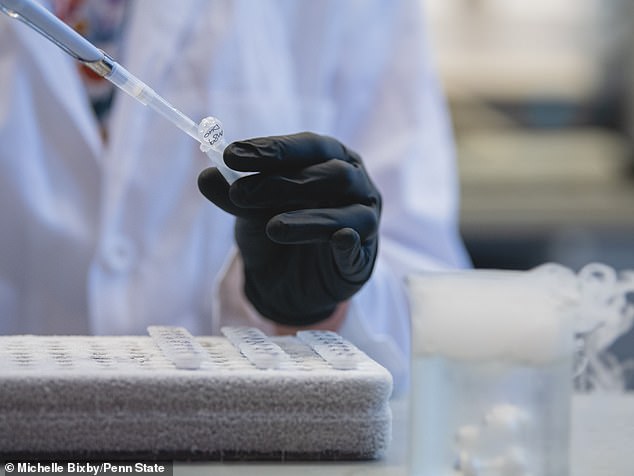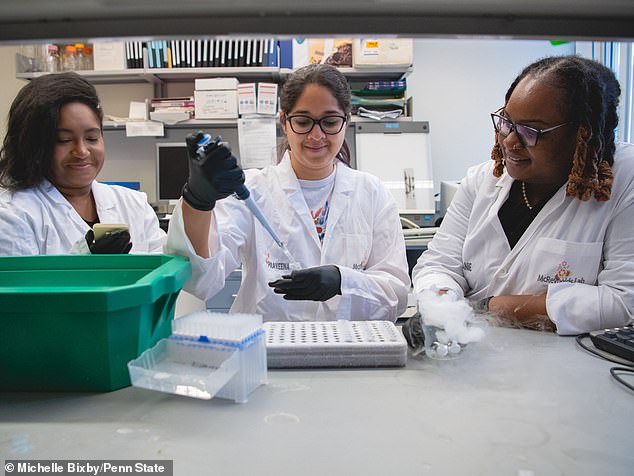The key to stopping Alzheimer’s disease before it starts may lie in a drug that doctors already use to treat another disease, a landmark new paper suggests.
Researchers at Penn State and Stanford used a type of cancer drug to repair one of the first systems damaged in dementia: the way the brain uses energy.
The drugs, which worked to restore sugar levels supplied to nerve cells, revitalized the brains of mice treated with the therapy, protecting their memory and potentially reversing dementia.
This is the first treatment of its kind that promises to treat the causes of Alzheimer’s, not just control the symptoms of the disease, the study authors said.
Penn State researchers (pictured) focused on an entirely new theory for how Alzheimer’s may begin: shifting from treating the symptoms of the disease to treating the cause.

In the early stages of Alzheimer’s disease, the cells that supply energy to neurons stop doing so as efficiently as they would in a normal brain. Researchers focused on this degradation
This has potential implications for the nearly 7 million Americans currently living with Alzheimer’s disease.
By 2050, The Alzheimer’s Association predicts that number will reach 13 million and cost Americans nearly $1 trillion a year.
Dr. Melanie McReynolds, co-author of the paper and the Dorothy Foehr Huck and J. Lloyd Huck Chair in Biochemistry and Molecular Biology at Pennsylvania State University, said, “In the broader context of aging, neurological decline is a major cofactor in the failure to age healthily.”
The benefits of understanding and treating metabolic impairment in neurological disorders will impact not only those who are diagnosed, but our families, our society, and our entire economy.
Currently, medications available to treat the disease focus on removing proteins from the brain called beta-amyloid plaques.
But a growing number of neuroscientists suspect that these plaques do not cause dementia and are instead a symptom of the disease.
Treating these plaques is therefore like giving Advil to someone who has a cold. It may relieve some discomfort, but it will not eliminate the bacteria from your system.
Instead, this treatment aims to stop Alzheimer’s before symptoms begin, including memory loss, confusion, and language loss.
One of the many things that happens at the molecular level early in Alzheimer’s disease is that neurons stop receiving as much sugar or energy as they need.
This makes them weaker and sicker, said Dr. Paras Minhas, a resident at Memorial Sloan Kettering Cancer Center.
The researchers considered that this loss of energy could be a potential cause of Alzheimer’s disease. In their article, published in published in the journal ScienceThey focused on an enzyme called indole-2,3-dioxygenase (IDO1), which they believed could be behind this breakdown.
They used a type of drug called IDO1 inhibitors, which prevent the enzyme from working properly and hinder the transport of sugar to neurons.
This is the same type of drug that is being developed to treat skin, breast and blood cancer. There are not many of these drugs in use at the moment.
One of them, called Verzenio, which is used for breast cancer, works approximately $15,000 per month No insurance. It is taken in pill form.
The researchers used this type of therapy on mice and on cells they had grown in the lab that showed symptoms of Alzheimer’s. In both cases, the anticancer drugs helped keep the brain cells that feed neurons healthy, so they could continue to produce energy for the neurons to use.
This stopped the formation of the telltale signs of the disease, beta-amyloid plaques, said Praveena Prasad, a doctoral student at Penn State who contributed to the research.

The researchers tested the therapy on mice and on cells they had grown in the lab. The next steps will involve testing the theory on more animals and eventually on humans.
“We are showing that by acting on brain metabolism we can not only slow down, but reverse the progression of this disease,” he said.
Part of the reason dementia research is so difficult is because scientists have not yet determined its causes.
Researchers are not saying that this loss of energy in brain cells is the only cause of Alzheimer’s, but it is a new theory that could help them unravel the mystery.
And that’s thanks to a drug we’ve already developed, said lead author Dr. Katrin Andreasson of Stanford University School of Medicine.
Dr Andreasson said: “Inhibiting this enzyme, particularly with compounds that have previously been investigated in human clinical trials for cancer, could be a major step forward in finding ways to protect our brains from damage caused by ageing and neurodegeneration.”
Still, they will need to test it in more complex animal models and eventually in humans before it proves widely useful. The drugs could still fail at any point in that process.
And even if it is successful in the next rounds of testing, it will still be years before it becomes a widely available treatment for dementia.
Some studies have said that it takes on average 7.5 years for a drug to pass clinical trials in the United States. Although, since some types of IPO1 drugs have already been deemed safe in humans, it is unlikely to take that long.

